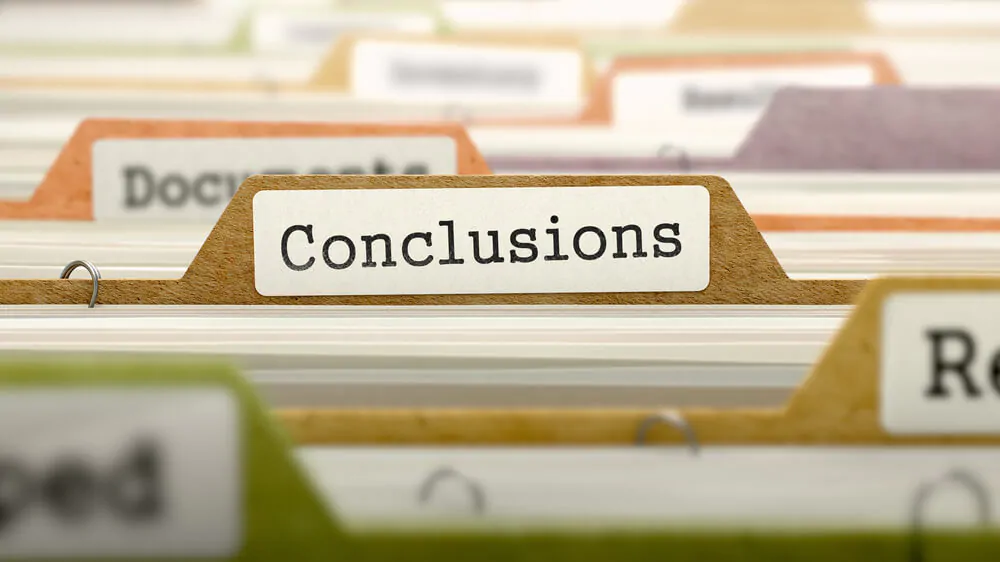In this article, we explain how to write a conclusion or a strong ending that leaves the reader wanting more.
Whether you’re writing a thesis paper or a non-fiction book, you are going to need an effective conclusion. A conclusion should summarize the main points of the work, so the reader walks away with a basic idea of what you have written.
Yet the conclusion should not simply repeat everything you said in your body paragraphs. In fact, for some writers, the concluding paragraphs are the hardest to write, because they want to say something else about the work without simply restating everything they already wrote.
Learning how to write a conclusion is an important part of becoming a good writer, and this guide will help.
Contents
How to Write a Conclusion Paragraph

So when you come to the end of your piece of writing, you need to create a conclusion paragraph. This paragraph answers the reader’s question of “so what?” about what you have written. It gives a “why” to what you have already stated.
So how can you write one? Here are some steps to follow that will make your conclusion strong.
Step 1. Tie in Your Thesis Statement
Tie your conclusion back to your original thesis statement. While you do not want to copy it word-for-word, you can restate it in a different way.
Doing this shows the reader why you spent the time writing your piece to support your original idea.
Step 2. Restate Your Main Points
Next, restate your main points. Summarize the ideas differently than you originally discussed.
The reader should come away from the conclusion with a thorough review of everything you said in your writing.
Step 3. Connect to Your Opening Statements
Connect your conclusion to the introduction in some way. Since the introduction likely had your thesis statement, this is one way to do so, but you can also tie in the two by stating similar concepts or reviewing the story you opened the piece using.
Step 4. Add Additional Insight
A good conclusion to a research paper or essay will add a bit of insight to the piece. This is where you tell people why they should care about what you wrote.
Your additional insight can create a sense of closure as well. The reader should come away from the closing sentence with a feeling that the piece is complete and they have all of the information they need.
What to Avoid in Your Conclusion

When writing a conclusion, you need to avoid some common mistakes. Remember, this is where you want to bring your ideas full circle and leave the reader with a final impression of your writing. As such, avoid these problems:
- Do not introduce a new idea or thesis in the conclusion. If you have something further to say on the topic, it needs to be placed elsewhere in the piece.
- Do not use words like “in summary” or “in conclusion”. The reader should know that you are writing the conclusion and does not need you to state this.
- Avoid changing the tone of your piece. This should stay constant from the first sentence to the final word of your writing.
Basic Outline of a Conclusion
There is a basic outline you can follow when writing a conclusion paragraph. Here is the template to follow:
- Topic Sentence:Repeat your thesis statement in a new way to be the topic sentence of your paragraph. Don’t restate it exactly. While this isn’t plagiarism, it is boring to read.
- Supporting Sentences: Restate your main arguments and points in the next sentences. Connect the ideas to one another.
- Closing Sentence: this is your final statement, call-to-action or concluding thought. It finishes the entire piece.
Common Types of Conclusions
There are three main types of conclusions you can make in a piece of writing. These include:
- Summarizing: These conclusions rehash the main points of the essay or report. They show the importance of your ideas and cover the key points so the reader remembers what you spoke on. A summary conclusion does not give opinions or feelings.
- Editorializing: These conclusions are part of argumentative essays, and they state the implications of your argument. They may also include a call-to-action on the topic or try to create a personal connection with the reader. This is the type of conclusion that talks about feelings and beliefs.
- Externalizing: These conclusions transition from your essay or paper to further study or some future research on the topic. This is particularly helpful in papers on complex subject matter.
A Final Word on How to Write a Conclusion
If you follow the basic outline and void common mistakes, you can learn how to write a conclusion that works. Your conclusion gives you the chance to have the last word on your topic and make a restatement of your main ideas. It rounds out the body of the paper and makes your work look finished.
A strong conclusion also has a major impact on the reader. If you have done your job right, it leaves the reader with a new understanding on the topic you have written about and draws the reader to your main conclusion.
FAQs on How to Write a Conclusion
How to write a conclusion for an essay?
When you are writing an essay, you will use a basic structure of introduction, supporting paragraphs, and conclusion. The conclusion paragraph will restate your thesis and your supporting paragraphs in a concise, simple format.
How to write a conclusion in a research paper?
A conclusion in a research paper will restate your thesis statement and your main outline points. You may not have room in one paragraph for all of the points of your paper, but the main points get restated in the conclusion.